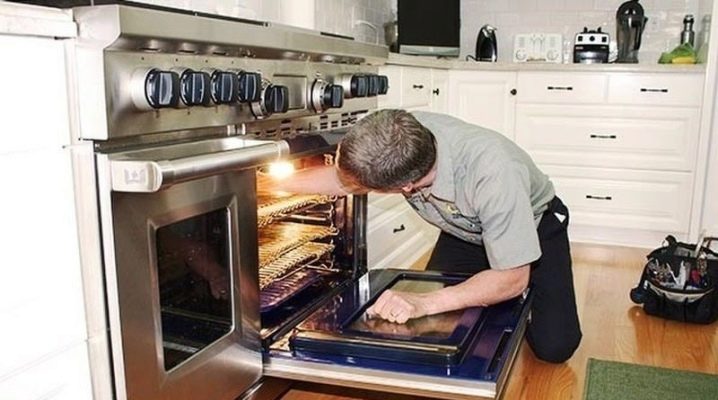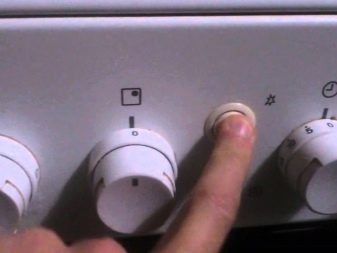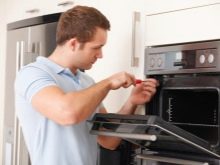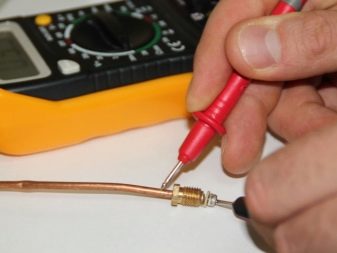Repair of an oven in a gas stove: signs and causes of malfunctions, remedies

The oven is an irreplaceable assistant in the kitchen of every housewife. When equipment breaks down or breaks down during cooking, it is very frustrating for the owners. However, don't panic. Many breakdowns can be repaired with their own hands, and the rest can be easily eliminated by the masters of service centers.
Malfunction symptoms
The principle of functioning of a gas oven is to heat up the air by burning gas coming from a city pipeline or cylinder. The supply of natural fuel is regulated by a valve on the gas pipeline. The fuel then flows through the nozzle, mixes with the air and ignites, providing the heat required for cooking. Most often equipment malfunctions are caused by malfunctions in the gas control system, which causes the fire to suddenly extinguish. Signs that the gas stove oven is not working are as follows:
- gas flows, however, when the button is pressed, the flame does not ignite;
- the device heats food weakly or unevenly;
- the doors do not fit well or the oven does not close;
- the fire goes out some time after ignition;
- the heat in the oven is not regulated;
- does not go out while holding the pen;
- the fire is yellow-red, the oven smokes;
- the flame of the burners has different heights;
- jamming occurs when the door is opened;
- the oven gets very hot during operation.




Causes
Gas is a source of extreme danger. Mixing with air, it becomes flammable and explosive, so there are only a number of steps that you can take when repairing yourself without calling a qualified technician. You can identify some possible reasons for what is happening. The main ones are as follows.
- Lack of oxygen. May cause fire problems. Try starting the device with the door open.
- Burners clogged. Perhaps this part is simply contaminated with combustion products, then the heat goes unevenly or it is simply not enough. The gas control system can shut off the gas supply, considering that there is no flame, the fire will go out immediately after releasing the handle. The problem is easily solved. Dismantle the burner, clean and reinstall. When cleaning, use a liquid product, powdery substances spoil the technique.
- The torch is skewed. If the burner is improperly positioned or moved, it will result in uneven flame and heating, soot formation. Check the location of the part and correct if necessary.
- The fuel pressure in the gas pipeline has decreased. Check: perhaps there is no need to call the master, and the cause of the trouble lies in an almost empty cylinder or problems in the supply of gas to the gas pipeline. Low flame intensity may prevent the system from starting.
- Does not hold the regulator. Do you turn the knob but it doesn’t turn on? To check, try to ignite without it. Carefully dismantle the handle, keeping all the small parts that are difficult to find later. Arm yourself with pliers, lightly press down and turn the valve stem. When gas comes on, try to ignite.
- The auto-ignition function has broken. If the gas is on and the flame does not ignite, you should not keep the handle turned for a long time and gas the room. In the front center of the oven there is a hole for lighting with matches.
- The temperature sensor has moved out of the flame zone. Then it is necessary to return it to its previous position to resume work.




When the baked goods are poorly baked, the heat in the oven is low, it may be time to change the rubber door seal.
The best way to test the insulation is to hold your hand over the rubber band. Hot air is coming, which means it's time to call the master and change the insulation.
Despite the fact that ovens are "long-livers" among household appliances, and some of them have been operating for more than 50 years, malfunctions still occur due to breakdowns of parts inside the device. Sometimes wear of gas control components occurs. The contacts in the system may have oxidized and need to be cleaned. During operation, the thermocouple is also constantly heated, which leads to its destruction. Sometimes this part cannot be repaired. It is simply replaced with the same new one.
The temperature is maintained by a mechanical thermostat. It is a liquid filled cylinder. The appliance is located inside the oven. At high temperatures, the filling of the cylinder expands, pushes the valve, which closes the gas supply. If the oven is not hot enough for a long time, the thermostat may need to be replaced.



One of the reasons why the device cannot be turned on may be wear on the ignition unit or a faulty solenoid valve. The longer the service life, the greater the likelihood of such troubles. The valve is usually simply changed. The functioning of the unit can be checked. Turn off the lights in the room at night. Switch on the electric ignition. See the result:
- there is no spark at all - the wiring is damaged;
- the spark goes to the side - a crack in the candle;
- a spark of yellow or red color - the block has worked.



How to fix it?
Most often, in case of disturbances in the operation of gas ovens, the owners are in no hurry to contact specialists, hoping to carry out repairs on their own. What kind of breakdowns can and can be safely eliminated with your own hands? More on this below in our article.
- Cleaning the regulator knob. Shut off the gas supply before commencing repairs. Troubleshooting begins with cleaning the taps. After removing carbon deposits, dirt and grease from them, clean the spring. Wipe the cork carefully so as not to damage it. Violation of the surface will cause gas leakage. Use only a soft sponge. Next, the plug is treated with graphite grease without touching the holes. Fat plaque is removed from the stock with a knife. After collecting the handle in reverse order.
- How to fix oven doors. Over time, the fastening of the oven door becomes loose, then it does not fit tightly or does not close. To fix the problem, unscrew the fixing screws that connect to the plate. Having loosened them well, move the door in different directions until you find the position in which it has completely sat on the hinges. To check, place a sheet of paper between the seal and the edge of the oven. If it does not grip well, repeat the procedure. After installing on the hinges, the bolts are screwed into place.



If it is noticed that the loss of heat is associated with damage to the seal located around the perimeter of the door, it will not be difficult to replace it.
- Remove the old seal. In some models of the oven, it can be attached with screws, to get to them, pull back the protruding edge of the rubber, in others it is glued.
- Clean the duct and door with liquid detergent. Remove residues of old sealant or glue. Degrease.
- Install a new seal by starting to fasten it from above, then down and to the sides. Finish the process by joining the edges in the center at the bottom. If gum needs to be glued, select food grade heat resistant glue up to 300º.


Among other breakdown options.
- Checking and stripping the thermocouple. The oven is on as long as you hold the handle - then you need to check the thermocouple attachment. In the lowest position, it should touch the tongue.If not properly positioned, most models allow for adjustment with screws. It is possible that the thermocouple contacts are dirty and this interferes with the maintenance of the flame. Try sanding the part with sandpaper.
When these procedures are not sufficient, the thermocouple will most likely need to be replaced.


- Replacing the heating coil. If the oven does not heat up due to the failure of the heating coil, you can replace it yourself. This plate part is sold in the electronics department. To replace it, you need to remove the back surface of the case, release the spiral from the fasteners, unfasten the porcelain beads. Then place the new spiral in its original place and secure. Assemble the oven.
It happens that in the process of long-term operation, rust corrodes the surface of the case, holes are formed. You can weld a burnt-out body outside the oven by cleaning such places with sandpaper using cold welding. When the weld is set, it is sanded and covered with enamel.


- There is a smell of gas. If the stove does not work, and you smell gas, then there is a gap somewhere in the pipeline, a leak occurs. Shut off the fuel supply, call and call the emergency gas service. Further work can only be carried out by qualified specialists. To locate the leak, disassemble the device and apply soapy foam to all connections of the gas tube outside and inside the oven. Bubbles will appear where fuel comes out. Check all regulators, handles and taps. Remove the side plate of the slab and prevent leakage in the internal structure.

Prevention measures
Regular preventive maintenance of the appliance will help to avoid breakdowns and prolong the operation of the oven. Observe the operating instructions for the equipment. Adhere to the technology of cooking different dishes and the recommended temperatures for them. View the design of the various oven accessories. Recommendations for cleaning and lubricating the elements are also important.
After the end of the baking or braising process, always keep the sides and bottom clean, this will help to improve the functioning of the appliance. Remove dirt and food debris. This will prevent the internal parts of the oven from clogging and deteriorating. Use good quality household cleaning products. Cheap powdered products scratch the glass of the door, destroy the enamel, make the seal hard.

Ovens are considered reliable appliances. If the device breaks down, specialist assistance is not always required. Some faults can be repaired with your own hands. For example, to clean individual elements, replace regulators, seals, heating coil, adjust the oven door and thermocouple. When it is not possible to find the cause of the breakdown, you cannot do without calling the service center employee. Usually problems can be solved, and repairs do not take long.
For information on how to repair an oven in a gas stove, see the next video.













The comment was sent successfully.